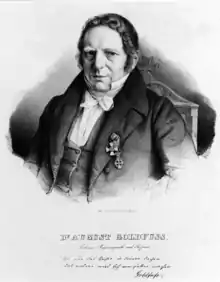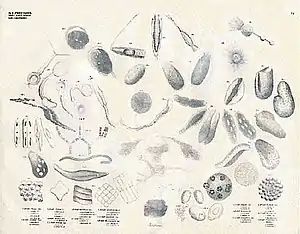Georg August Goldfuss
Georg August Goldfuss (Goldfuß, 18 April 1782 – 2 October 1848) was a German palaeontologist, zoologist and botanist.

Georg August Goldfuss | |
|---|---|
| Born | 18 April 1782 |
| Died | 2 October 1848 (aged 66) |
Goldfuss was born at Thurnau near Bayreuth. He was educated at Erlangen, where he graduated Ph.D. in 1804 and became professor of zoology in 1818. He was subsequently appointed professor of zoology and mineralogy at the University of Bonn. Aided by Count Georg zu Münster, he issued the important Petrefacta Germaniae (1826–44), a work which was intended to illustrate the invertebrate fossils of Germany, but it was left incomplete after the sponges, corals, crinoids, echinoderms and part of the mollusca had been figured. A collection of Goldfuss' botanical specimens are housed at Bonn University.[1] Goldfuss died at Bonn.[2]
In 1820, he coined the word protozoa to refer to single-celled organisms such as ciliates.[3]
References
- "HUH entry for George August Goldfuss". Index of Botanists. Harvard University Herbarium. Retrieved January 5, 2012.
- Chisholm 1911, p. 211.
- Scamardella, J. M. (1999). "Not plants or animals: a brief history of the origin of Kingdoms Protozoa, Protista and Protoctista" (PDF). International Microbiology. 2 (4): 207–221. PMID 10943416. Archived from the original (PDF) on 14 June 2011.
- IPNI. Goldfuss.
- Attribution
 This article incorporates text from a publication now in the public domain: Chisholm, Hugh, ed. (1911). "Goldfuss, Georg August". Encyclopædia Britannica. 12 (11th ed.). Cambridge University Press. p. 211.
This article incorporates text from a publication now in the public domain: Chisholm, Hugh, ed. (1911). "Goldfuss, Georg August". Encyclopædia Britannica. 12 (11th ed.). Cambridge University Press. p. 211.
Literature
- Georg Uschmann (1964), "Goldfuß, August", Neue Deutsche Biographie (NDB) (in German), 6, Berlin: Duncker & Humblot, pp. 605–605
- Wolfhart Langer: Georg August Goldfuß - Ein biographischer Beitrag in: Bonner Geschichtsblätter, Band 23/1969, S. 229-243
External links
- Georg August Goldfuss in the German National Library catalogue
